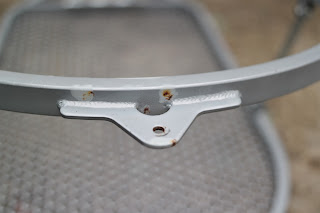So, having awoken the
Holdsworth from its Seasonal slumber, it would be rude not to ride it. Through the Soma Condor might look a little
curious, from certain angles, they and the Tektro R200 are proving a hit with me.
Something I wasn’t complexly sure would be the case.
During our maiden blast, I was
somewhat perturbed to discover the Apeman A80 Action cam https://www.sevendaycyclist.com/apeman
mount imploding at 23mph. Thankfully, I
averted its loss and our mutual collision with terra-firma. Action cam safely stuffed
in jersey pocket, I continued to assess the most recent mods, while sporting a
massive grin.
Back home, rummaging through a
brackets box, I uncovered this K-Edge Go-Pro mount. Thankfully, the Apeman casing
was plug n’ play compatible. No all Go Pro homages are. Once upon a time, I
only considered action cams a means of capturing the sights n’ sounds of a
ride. The past few years have seen me deploy them, to record driver aggression.
Unfortunately, the housing fractured, almost
64 years young, those plain
gauge 531 tubes still deliver a responsive, and refreshingly compliant ride.
Obviously, carbon blades and a titanium stem help in that regard, while keeping
the weight down.
The Condor have brought the
cockpit a little closer, so I slid the BBB Razer saddle back a few millimetres
to offset this. However, I’ll leave it 100 miles before reaching for an Allen key.
Unless of course, the post cradle bolt should loosen.
Elsewhere, I dropped by Maldon
Shot Blasting & Powder Coating. Part social, part features cum favour based.
Work had begun on the Holdsworth Cyclone frameset. Blasting revealed a pin
dent, minor pitting and corrosion. This is not unexpected, given the frame’s
age.
Much of this was evident where
electroplating and paint overlapped. I fully appreciate why the owner wanted to
preserve the original electroplating. However, getting paint to adhere successfully
is a challenge. Even the most experienced paint shops struggle.
Acid etch primers were the
most successful default, but even they lose tenure eventually. The colour coats will be water-based, sealed
under a polyester (powder coat) lacquer. In common with cellulose paints,
water-based paints can be built up to produce a phenomenally deep, glossy sheen.
Hence their adoption by many prestige
car manufacturers. These are usually sealed under a 2K lacquer. For durability
and adhesion, Chris has treated the cyclone, to a zinc rich epoxy powder coat
primer.
With the head tube masked, the
wet spray colour coats can commence. These will be topped off with a clear,
polyester powder lacquer. Arguably powder coated acrylics offer the best
aesthetic but polyester has the edge, where outright durability’s concerned.
Staying with sealants and lacquers
a moment, while semi-permanent lacquers, such as Crankalicious Enduro Frame
Sealant https://www.sevendaycyclist.com/crankalicious-enduro-frame-sealant-
aren’t designed to defend pricey
paintwork from dings, scratches and similar damage, they do offer a useful protectant
barrier.
The sort that resists road
salt, oily spatter and makes the bike easier to clean. My one lament concerning
my Univega’s otherwise excellent cream finish, is its tendency to show every
oily finger mark. No matter how thoroughly I wax it. Well, I’m pleased to
report sealants have saved the day.
Fenwick’s Professional Protective
Coating has proved extremely effective. Compatible with gloss, matt and satin
finishes, it’s a water-based formula that you work into clean dry surfaces.
Buff to ashine and ideally, leave curing eight hours. This ensures it won’t
transfer to hands, or other, unwanted regions of the bike’s anatomy.
Fenwick’s reckon a single
application will last up to 6 months. A bit early to comment one way, or the
other. Nonetheless, the invisible, slippery layer is more apparent than most
and crucially, it seems to be keeping “Ursula” clean, in much the same fashion,
a traditional, permanent lacquer would.













































